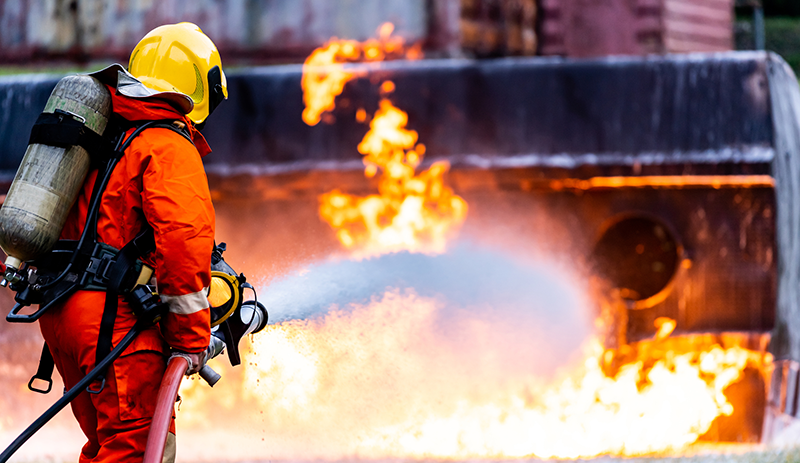Aqueous Film Forming Foam, commonly referred to as “AFFF”, is a firefighting foam used to combat fires by coating their fuel in a thick film, preventing oxygen contact and flammable vapors. AFFF is commonly used to extinguish chemical fires.
When sprayed, AFFF covers the surface of the burning material and forms a blanket that suffocates the fire. AFFF creates an obstruction between the fuel and the oxygen that helps to prevent the fire from spreading and/or reigniting.
Aqueous Film Forming Foam has been used by firefighters, military bases, and airports since its creation in the 1960s. Soon after, scientists warned of the danger of cancer from exposure to the chemicals found in AFFF.
For decades, AFFF has been used to extinguish Class B fires that involve flammable liquids such as cooking oils, gasoline, paints, or jet fuel. AFFF contains chemicals known as “PFAS” which are known to be carcinogenic to humans.
PFAS are bioaccumulative, meaning they remain intact in the body and build up over repeated exposures. Health organizations such as the Environmental Protection Agency (EPA), Center for Disease Control (CDC), and American Cancer Society (ACS) have warned about PFAS.
PFAS, or per- and polyfluoroalkyl substances, are a group of chemicals used to make fluoropolymer coatings and products that resist heat, oil, stains, grease, and water. They are a group of long-lasting chemicals that break down slowly over time. Multiple scientific studies have looked at these chemicals and their effects on people. While there is still much to discover, these reports have linked PFAS exposure to multiple types of cancer.
Over the course of many decades, countless service members and firefighters have been exposed to PFAS from AFFF in the line of duty. Now they face an increased risk for multiple forms of life-threatening cancers linked to AFFF.
Carcinogens Found in AFFF Foam
Perfluorooctanoic acid (PFOA) and Perfluorobutane sulfonic acid (PFOS) are the two PFAS chemicals in Aqueous Film Forming Foam. Both are fully fluorinated organic compounds that will highly resist normal environmental degradation and have been found in the environment and drinking water. While the production of PFOA and PFOS has ended in the U.S., these chemicals were found in AFFF fire fighting foam until recently.
The risk of AFFF cancer is long-lasting, meaning cancer may develop years or even decades after exposure. PFAS chemicals pose a risk even in small amounts, and firefighters and service members who used AFFF to fight fires have been exposed to significant amounts of these carcinogens.
Since the early 1990s, medical studies have consistently found that PFAS chemicals in AFFF cause cancer. Today, the manufacturers of AFFF face difficult questions from fire fighters, military personnel and their loved ones as to why these products were still manufactured long after the risk of AFFF cancer became clear.
The following are the various types of cancers that can be caused by routine exposure to firefighting foams:
- Kidney cancer
- Prostate cancer
- Testicular cancer
- Lymphoma
- Bladder cancer
- Leukaemia
- Thyroid cancer
- Liver cancer
- Pancreatic cancer
- Breast cancer
Cancer of the prostate, testicular, bladder, kidney, and thyroid are the most common.
AFFF Cancer Research
At this time, AFFF cancer research has been conducted in three main areas. Together, these three paint a picture of AFFF cancer, confirming a correlation and suggesting how it may occur.
1. Lab testing with animals. Animals in labs exposed to PFAS substances such as those found in AFFF have developed cancerous tumors, thus confirming PFAS substances are carcinogenic.
2. Examination of populations known to have been exposed to PFAS in drinking water. A large-scale study was conducted between 1996 and 2005 in communities near Dupont's Teflon manufacturing plant in West Virginia and Ohio.
PFOA, which was a common ingredient in AFFF for decades, was known to have contaminated the drinking water serving approximately 70,000 people in those communities. Researchers identified elevated rates of non-Hodgkin's lymphoma, kidney cancer, testicular cancer, prostate cancer and ovarian cancer in this population.
3. Comparison of PFAS substances to known carcinogens: Cancer researchers from the Environmental Working Group and Indiana University examined the characteristics of twelve PFAS chemicals. Each substance was found to share at least one trait of common carcinogenic substances, including the following characteristics: they alter human DNA, weaken the immune system, induce chronic inflammation, and cause cell proliferation.
People are at risk for AFFF cancer when synthetic PFAS chemicals accumulate in the body. Those most at risk include those who used AFFF foam containing PFAS chemicals for crash- and fire-response training, equipment testing and emergency response at airports, military bases and training sites around the country.
AFFF Lawsuits
Victims of AFFF cancer and their families should know that they have every right to sue AFFF manufacturers to pursue compensation for suffering, medical expenses and loss. Filing a AFFF lawsuit can serve to hold manufacturers accountable for the disregard for the safety of servicemembers and firefighters.
Filing an AFFF cancer claim is also the only means to pursue the compensation your family deserves. There is no question that the use of AFFF foam containing PFAS has resulted in significant health concerns for firefighters and servicemembers. Lawsuits are now underway against AFFF manufacturers, as ongoing research reveals more thoroughly the detrimental effects on health from exposure to PFAS.
Some of the manufacturers facing litigation for producing harmful AFFF foam containing PFAS include:
- 3M
- Chemours
- Arkema
- Dynax Corporation
- Corteva
AFFF Lawsuits: No Fees Unless We Collect for You
We represent AFFF lawsuits for cancer on a contingency basis, meaning we never charge legal fees unless we win compensation in your case.
Filing a lawsuit will allow you to hold those responsible for damages, while also providing real compensation for medical expenses, suffering and loss. Contact us today for your free consultation.

